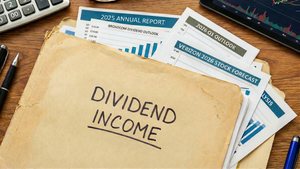
Chord Energy (NASDAQ: CHRD) recently announced a quarterly dividend of $1.30 per share, a move that underscores the company's commitment to delivering consistent shareholder returns. Declared on August 6, 2025, with an ex-dividend date of August 20, 2025, and a payment date of September 8, 2025, this dividend reinforces the energy producer's capital allocation strategy. While providing a steady income stream for investors, the declaration also brings into focus the company's financial health and its position within the broader energy market.
The dividend, which translated to an annualized yield of approximately 5-6%, had immediate implications for both Chord Energy and its investor base. For shareholders, it represented a tangible return on investment, particularly appealing to those focused on income generation. For the company, it signaled confidence in its operational performance and cash flow generation, even as it navigated the volatile landscape of the energy sector. However, some analyses of payout ratios suggested careful consideration of sustainability, hinting at a potential balancing act between rewarding shareholders and retaining capital for future growth.
A Commitment to Shareholder Value: Deep Dive into Chord Energy's Dividend Strategy
The declaration of a $1.30 per share quarterly dividend by Chord Energy (NASDAQ: CHRD) on August 6, 2025, was not an isolated event but a clear affirmation of its established capital allocation strategy. This specific dividend, with an ex-dividend date of August 21, 2025, and payment on September 8, 2025, forms a crucial component of the company's "base-plus-variable" approach to shareholder returns. This policy aims to provide a consistent base dividend while offering additional variable distributions and robust share repurchase programs, particularly when commodity prices are favorable.
Leading up to this announcement, Chord Energy had demonstrated a consistent trajectory of returning capital to shareholders, initiating dividends in 2022 and steadily building its program. The company has proudly announced total shareholder returns exceeding $5 billion since 2021, underscoring its dedication. Recent preceding declarations included a $2.52 per share base-plus-variable dividend for Q2 2024 (comprising $1.25 base and $1.27 variable) and a $1.30 per share base dividend for Q1 2025. These actions, alongside significant share repurchases—such as the $216.5 million buyback following the Q1 2025 base dividend—paint a picture of a company prioritizing direct shareholder benefits.
Key players in this decision include Chord Energy's management team and its board of directors, responsible for shaping the financial strategy and capital allocation. Stakeholders primarily consist of its diverse shareholder base, ranging from individual income investors seeking regular payouts to institutional investors focused on total shareholder return. The August 2025 dividend declaration coincided with the release of Chord Energy's Q2 2025 financial and operating results, which reported strong operational performance and Adjusted Free Cash Flow exceeding expectations.
Initial market and industry reactions to the comprehensive announcement were generally positive. The combination of better-than-expected financial results, a consistent base dividend, and the authorization of a new $1 billion share repurchase program signaled robust financial health and a steadfast commitment to shareholder value. While direct, immediate stock price movements solely attributable to the dividend were not isolated, the overall package of announcements was well-received, reinforcing Chord Energy's attractive dividend yield and its strategic position within the independent oil and gas sector.
Ripple Effects: Winners and Losers in the Wake of Chord Energy's Capital Return Strategy
Chord Energy's (NASDAQ: CHRD) consistent dividend declaration and robust capital return strategy are not isolated actions but rather a reflection of, and a contributor to, a significant shift within the independent Exploration & Production (E&P) sector. By prioritizing free cash flow generation and returning a substantial portion of it to shareholders through base dividends, variable dividends, and aggressive share repurchases, Chord Energy sets a high benchmark for capital discipline that has distinct implications for various market participants.
Among the potential winners are other independent E&P companies that have similarly embraced a shareholder-friendly capital allocation model. Companies with strong balance sheets, efficient operations, and a proven track record of generating significant free cash flow are likely to be viewed favorably by investors, who are increasingly prioritizing consistent returns over aggressive production growth. Chord Energy's success in this area validates the strategy, potentially drawing more investor capital towards peers that can demonstrate similar financial prudence and commitment to shareholder value. This also benefits investors themselves, particularly those seeking stable income streams and total shareholder returns in a traditionally volatile sector.
Conversely, E&P companies that lag in adopting such capital discipline or possess weaker financial positions might find themselves at a disadvantage. Those unable to consistently generate sufficient free cash flow or commit to substantial shareholder return programs may appear less attractive to investors, potentially leading to capital outflows or increased pressure to re-evaluate their strategies. The market is increasingly scrutinizing payout ratios and the sustainability of returns, making it challenging for companies that prioritize growth at the expense of immediate shareholder value.
Furthermore, the E&P sector's intense focus on efficiency and cost control, driven by companies like Chord Energy, places considerable pressure on oilfield service (OFS) providers. While E&P capital expenditures continue, operators demand more for less, pushing OFS companies to deliver services at lower costs and with greater innovation. This dynamic can lead to squeezed margins and overcapacity within the OFS sector, necessitating strategic adaptations, technological advancements, and potentially consolidation among service providers to remain competitive. The broader energy market thus witnesses a recalibration, where capital flows are increasingly directed towards companies that can demonstrate both operational excellence and a clear pathway to shareholder value.
A Bellwether for the Industry: Chord Energy's Dividend in a Shifting Landscape
Chord Energy's (NASDAQ: CHRD) consistent commitment to shareholder returns through its $1.30 per share dividend is not merely a company-specific event but a powerful indicator of broader, transformative trends sweeping through the energy industry. This move firmly aligns with the post-2014 and post-COVID-19 paradigm shift in the Exploration & Production (E&P) sector, which has decisively moved away from a "growth at all costs" mentality. Today, the emphasis is on stringent capital discipline, robust free cash flow generation, and the prioritization of shareholder value through a combination of base and variable dividends, alongside strategic share repurchases. Companies like Chord Energy are now focused on "profitable growth within means," carefully managing capital expenditures, reducing debt, and optimizing their highest-return inventory.
These strategic shifts have profound ripple effects. For competitors, Chord Energy's approach sets a compelling benchmark, intensifying pressure on other independent E&P companies to demonstrate similar levels of capital efficiency and shareholder returns. Those unable to adapt risk losing investor confidence and capital. For partners, including joint venture collaborators and midstream operators, a financially disciplined E&P company focused on sustainable returns offers a more predictable and stable long-term engagement. However, the relentless pursuit of operational efficiency and cost control, a hallmark of this new era, can also translate into increased pressure on service providers and other partners to deliver more value at competitive prices.
The broader regulatory and policy environment also plays a crucial role, indirectly shaping a company's capacity for shareholder returns. Government stances on oil and gas production, evolving tax regimes, and trade policies (such as tariffs) can significantly influence an E&P company's operational costs and cash flow generation. Moreover, the accelerating global energy transition and increasing pressure for Environmental, Social, and Governance (ESG) disclosures are reshaping investment landscapes. While not directly regulating dividends, these policies create the economic backdrop against which capital allocation decisions are made, influencing investor access and the long-term viability of different energy projects.
Historically, the energy sector has been cyclical, and the current emphasis on shareholder returns draws parallels to previous periods of industry recalibration. A significant precedent emerged post-2014, when a prolonged bearish sentiment forced E&P companies to fundamentally transform their investment strategies from growth-centric to shareholder-centric, thereby restoring investor confidence. The "modest growth, high return" model exemplified by Chord Energy echoes earlier periods where companies aimed to build substantial cash reserves for distribution to shareholders. This approach is particularly critical in managing the inherent volatility of commodity markets, providing a buffer during potential downturns and ensuring sustained financial health.
The Road Ahead: Navigating Future Opportunities and Challenges
Chord Energy's (NASDAQ: CHRD) consistent capital return strategy sets the stage for a dynamic future, presenting both short-term stability and long-term strategic considerations for the company, its sector, and investors. In the immediate future, Chord Energy is poised to benefit from its robust financial position and operational efficiencies, particularly through the integration of recent strategic acquisitions like Enerplus and XTO Energy assets in the Williston Basin. This is expected to drive continued strong free cash flow, support consistent dividend payouts, and fuel share repurchases, potentially leading to further stock appreciation and attractive yields for investors.
Looking further ahead, Chord Energy's long-term viability hinges on its ability to sustain free cash flow generation, bolstered by its low base decline rate and continuous improvements in capital efficiency through advanced drilling techniques, such as the acceleration of 3-mile and 4-mile lateral developments. These longer laterals promise superior returns and increased estimated ultimate recovery (EUR), offering a buffer against market downturns and productivity declines. However, the long-term maturity of the Williston Basin, with projected production declines after 2025 and below 2023 levels by 2040, alongside a forecasted declining revenue, signals a need for continuous innovation and strategic management to maintain value.
Strategic pivots for Chord Energy will likely center on cementing operational excellence, successfully integrating acquired assets to unlock synergies, and maintaining flexible capital allocation to adapt to commodity price fluctuations. The company's focus on marketing optimization to maximize returns from existing production will also be critical. While currently concentrated on traditional oil and gas, the evolving energy landscape may necessitate future adaptations, such as exploring low-carbon opportunities or enhancing ESG performance, to sustain long-term investor appeal and navigate increasing environmental scrutiny.
The broader market presents a mixed bag of opportunities and challenges. Technological advancements in drilling and completion, coupled with continued consolidation within the E&P sector, offer avenues for growth and efficiency. Near-term oil and gas demand growth through 2030 and ongoing infrastructure improvements in key basins like the Williston also provide tailwinds. However, persistent commodity price volatility, increasing environmental and regulatory pressures, the depletion of easily accessible reserves, and the long-term maturation of established basins pose significant headwinds. Shareholder expectations for robust ESG performance will also continue to shape investment decisions and corporate strategies across the sector.
Potential scenarios for Chord Energy range from a base case of steady execution—maintaining flat oil volumes, robust shareholder returns, and healthy free cash flow—to an optimistic outlook where sustained high oil prices and successful 4-mile lateral acceleration lead to significantly enhanced free cash flow and increased distributions. Conversely, a pessimistic scenario involving prolonged low oil prices, technical integration challenges, or heightened regulatory burdens could result in reduced capital expenditures, lower production, and a contraction in shareholder returns. For the energy market as a whole, the trajectory will depend on the pace of the energy transition, geopolitical stability, and the industry's ability to innovate and adapt to both demand shifts and environmental imperatives.
Conclusion: A New Era of Discipline and Shareholder Focus in Energy
Chord Energy's (NASDAQ: CHRD) declaration of a $1.30 per share quarterly dividend serves as a compelling summary of the company's robust capital return strategy and a powerful emblem of the broader transformation sweeping through the independent Exploration & Production (E&P) sector. This move, part of a comprehensive approach that includes base and variable dividends alongside significant share repurchases, underscores Chord Energy's unwavering commitment to returning a substantial portion of its Adjusted Free Cash Flow (typically 69-90%) to shareholders. Bolstered by strong operational performance, including the successful execution of 4-mile lateral wells and strategic acquisitions in the Williston Basin, the company has solidified its position as a financially disciplined operator.
Moving forward, the energy market is firmly entrenched in a "capital discipline" paradigm, where a "shareholder-first" mentality has become the new reality. This fundamental shift, driven by the industry's imperative to restore investor confidence after periods of volatility and overspending, prioritizes strong returns on invested capital. While the inherent volatility of commodity prices—from WTI crude to Henry Hub natural gas—will always remain a critical factor, the industry's newfound flexibility in adjusting capital allocation strategies offers a significant advantage. Companies that can consistently demonstrate operational efficiency, technological adoption (such as longer laterals), and prudent financial management will continue to lead this evolving landscape.
The lasting impact of this strategic pivot is likely a more financially disciplined and investor-centric E&P sector. Companies like Chord, characterized by strong balance sheets, efficient operations, and a steadfast commitment to consistent shareholder returns, are better positioned for long-term sustainability and attracting investors. This transformation effectively redefines energy stocks, making them potentially attractive income-generating assets that can offer a hedge against inflation. The shift from aggressive, often unsustainable, growth to a focus on generating sustainable free cash flow marks a significant maturation of the industry, fostering greater stability and predictability.
For investors, the coming months will require vigilant monitoring of several key indicators. Beyond the obvious fluctuations in commodity prices, particular attention should be paid to Chord Energy's updated production guidance and capital expenditure plans, which will signal its ongoing operational efficiency and investment strategy. The company's ability to consistently generate and allocate free cash flow, along with the strength of its balance sheet and leverage ratios (especially following recent acquisitions), will be paramount. Broader trends such as M&A activity within the E&P sector, the adoption of new drilling technologies, and the ever-present influence of geopolitical developments and evolving energy policies, including increasing ESG scrutiny, will also shape the investment landscape.
This content is intended for informational purposes only and is not financial advice


















